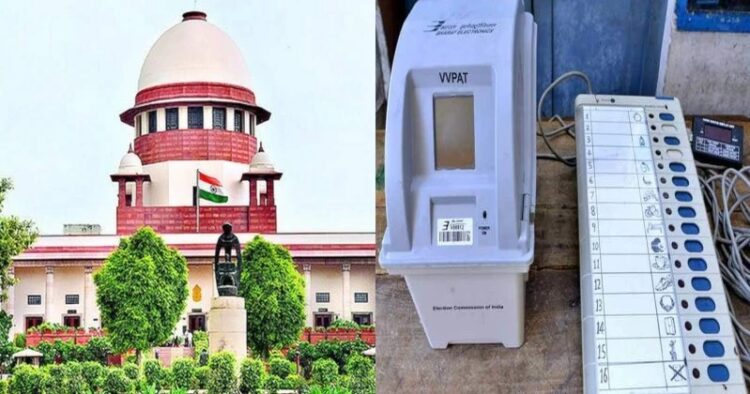The Supreme Court has raised concerns over the drawbacks of ballot voting while hearing petitions seeking cross-verification of votes cast on Electronic Voting Machines (EVM) with paper slips generated through the Voter Verified Paper Audit Trail (VVPAT) system.
The Supreme Court raised concerns about the drawbacks of ballot voting while hearing petitions regarding the cross-verification of votes cast on Electronic Voting Machines (EVM) with paper slips generated through the Voter Verifiable Paper Audit Trail (VVPAT) system. Justices Sanjiv Khanna and Dipankar Datta highlighted issues with the traditional secret ballot method during the proceedings.
During the hearing, Justice Sanjiv Khanna pointed to the challenges associated with the secret ballot voting method, stating, “We are in our 60s. We all know what happened when there were ballot papers, you may have, but we have not forgotten.” This remark came in response to arguments presented by Prashant Bhushan, counsel for one of the petitioners, who highlighted how most European countries that initially adopted EVMs have reverted to paper ballots.
Bhushan proposed alternatives such as providing VVPAT slips to voters or redesigning the VVPAT system to ensure transparency. He also mentioned the change in the VVPAT design from transparent glass to dark opaque mirror glass, raising concerns about visibility.
Addressing Germany’s example cited by Bhushan, Justice Dipankar Datta inquired about the country’s population, highlighting the disparity between India’s vast electorate of 50-60 crore voters and Germany’s population of around 6 crore.
Justice Khanna reiterated the need for caution, reminding that India has 97 crore registered voters. When Senior Advocate Sanjay Hegde advocated for tallying votes cast on EVMs with VVPAT slips, Justice Khanna questioned the practicality of counting 60 crore VVPAT slips.
During a hearing regarding the integrity of Electronic Voting Machines (EVMs), a judge emphasised the potential for human intervention to lead to problems and biases. He acknowledged that machines, without human interference, typically provide accurate results.
Prashant Bhushan, representing one of the petitioners, cited a research paper highlighting the possibility of EVM tampering. He criticised the practice of counting only 5 Voter Verifiable Paper Audit Trail (VVPAT) machines per assembly out of 200, which accounts for just 5 per cent and lacks justification. Bhushan also raised concerns about the seven-second light feature, suggesting that it could facilitate manipulation. He proposed allowing voters to take the VVPAT slip and deposit it directly into the ballot box.
Senior Advocate Gopal Sankaranarayan, representing another petitioner, echoed Bhushan’s concerns, emphasising the importance of voter confidence in the electoral process. While he clarified that there was no allegation of malice, he stressed the significance of ensuring transparency and trust in the voting system.
Amidst concerns and apprehensions surrounding the Electronic Voting Machine (EVM) system, petitions have been filed by the Association for Democratic Reforms (ADR) and activist Arun Kumar Agarwal, calling for cross-verification of every vote through the Voter Verified Paper Audit Trail (VVPAT).
The VVPAT allows voters to verify if their vote was cast properly and went to the candidate of their choice. It generates a paper slip that is stored in a sealed cover and can be opened in case of a dispute.
Arun Kumar Agarwal’s petition seeks the counting of all VVPAT slips, emphasising the importance of ensuring that every vote is accurately recorded. Meanwhile, the ADR’s petition urges the court to direct the Election Commission and the Centre to ensure that voters can verify through VVPATs that their votes have been “counted as recorded.”.
The plea points out a gap in the law, stating that while the VVPAT displays the vote for about seven seconds after pressing the button on the EVM, there is no provision for voters to verify that their vote has been “counted as recorded.”. This, according to the petitioners, contradicts the directions issued by the Supreme Court in the 2013 verdict of Subramanian Swamy versus Election Commission of India.
Meanwhile, Chief Election Commissioner Rajiv Kumar, while addressing the media last month, categorically brushed aside all the claims that were made questioning the credibility of the EVMs.
While referring to the verdict of the court upholding the credibility of the EVMs, Kumar had stated, “The courts have held EVMs are foolproof devices and that all allegations of tampering are baseless. SC asked us (EC) to count slips from five VVPATs per assembly segment and we complied.”



















Comments